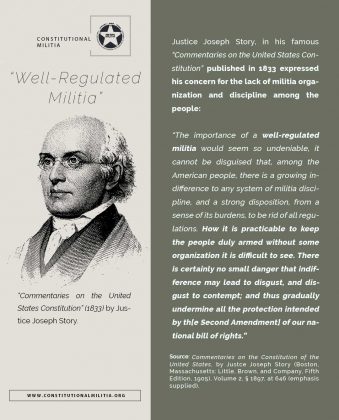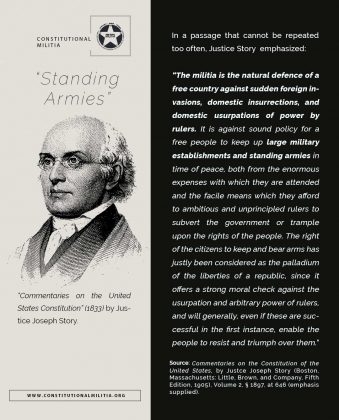Last Updated on January 4, 2022 by Constitutional Militia
“M” Word: “Militia”
Decade upon decade of disuse, misuse, and abuse have so thoroughly muddled the meaning of “Militia” in contemporary American political discourse that the word is hardly ever encountered except as invective, usually well-freighted with vituperative adjectives such as “extremist” and “violent”, broadcast by the enemies of constitutional government (and their dupes and other “useful idiots”) for the purpose of intimidating into silence the people they intend to oppress as soon as the vast majority of Americans has been thoroughly disarmed through one form of “gun control” or another.
The “M” Word: “Militia”
During the last hundred years, insouciant, incompetent, or intentionally rogue public officials have denied WE THE PEOPLE the proper organization of the Militia to which all Americans are constitutionally entitled. The history of “militia” in America during this period exhibits a sorry cavalcade of ignorance, confusion, conflicts, and exaggerated concerns for amassing institutional authority and advancing personal careers within the regular Armed Forces, the National Guard, so-called “State Guards” and “State Defense Forces”, and among various public officials of both the General Government and the States.[1] Perhaps even worse, devoid of a collective memory of the true state of affairs, deprived of relevant personal experience, and deluded by malign propaganda put out by the big media and various subversive special-interest groups, all too many Americans have come to treat the very noun “militia” as a dirty word that implies “extremism”, “racism”, “illegality”, “violence”, and even nascent “terrorism”—to the extent that not just a few patriots are reluctant even abstractly to advocate anything to do with the constitutional Militia any more, lest they be mocked, vilified, and politically ostracized for their efforts. Certainly a nadir of constitutionalism has been plumbed when constitutionalists themselves shrink from affirming the one and only institution the Constitution itself declares to be “necessary to the security of a free State”.[2]
“Gun control” is a neologism. Pre-constitutional American laws aimed at a near-universality of armament among able-bodied free adult male inhabitants, either through their own efforts or with the assistance of public institutions. In those days, had the term been current, “gun control” would have meant, not keeping firearms and ammunition away from as many private citizens as legislators might contrive to disarm, but instead seeing to it that as many citizens as possible possessed their own arms at all times, and were as well trained in the use of those arms as circumstances permitted. To employ the modern Judiciary’s mumbo jumbo, that and only that was considered to be “reasonable regulation” with respect to firearms. That the Colonies and independent States never attempted to exercise a purported power to disarm the general populace—and that no one of consequence ever seriously advocated that they should have done so—provides compelling evidence that no such power was ever believed to exist.[3]
The unfortunate but undeniable reality today is that “the Militia of the several States” are not constitutionally “organiz[ed], arm[ed], and disciplin[ed]”, either by Congress for the three purposes the Constitution explicitly allows,[4] or by their individual States for all other purposes (and for those first three purposes, too, should Congress continue to default in its duty in that regard).[5] Indeed, no true constitutional Militia is “organiz[ed], arm[ed], and disciplin[ed]” for any purpose anywhere within the United States. Rather, the vast mass of Americans eligible—and therefore constitutionally required—to serve in some capacity in the Militia has been relegated to the unconstitutionally oxymoronic, impotent, and even imbecilic “unorganized militia”.[6] As a result, no “well regulated Militia” exists in any State, which means that no State can—and, in light of the National para-military police-state apparatus being elaborated as of this writing at an ever-accelerating pace around the United States Department of Homeland Security, no State now does or without affirmative action on her part will hereafter—enjoy “the security of a free State”.[7]
Unfortunately, all too many Americans with otherwise sound patriotic instincts who should vocally support revitalization of “the Militia of the several States”—on the undeniably constitutional, as well as practical, ground that “well regulated Militia” are “necessary to the security of a free State” in their own personal interests where they themselves reside—have been so thoroughly cowed and demoralized by “gun controllers” black propaganda that they shrink from uttering the word “Militia” in public as part of a political proposal, lest they be vilified in the mass media as dangerous crackpots.[8]
To revitalize the Militia institution along strict constitutional lines we must use the term “Militia” because that’s the constitutional term and we’re not simply talking about a name. The legal authority of these structures depends upon their being within that explicit constitutional box.
Proponents of revitalizing “the Militia of the several States” must emphasize that the Militia are governmental entities, performing governmental functions, and composed of members of the supreme governmental authority in this country—WE THE PEOPLE. For “the Militia of the several States” are the very constitutional establishments they need to revitalize. “Militia” is the very name—the only name—the Constitution recognizes for these establishments, based upon some one hundred and fifty years of history in the Colonies and independent States.































